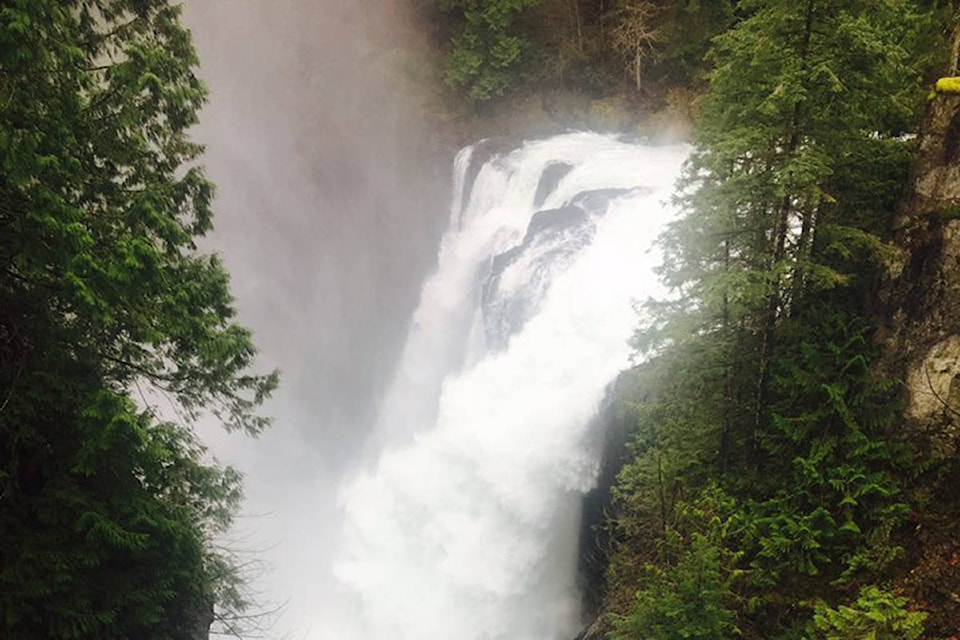UPDATE (JAN. 3, 2 p.m.): BC Hydro spokesperson Stephen Watson says, “Yesterday, we decided to increase the water release down Elk Falls to 80 m3/s versus 40 m3/s given the wet forecast. Given the high precipitation rates and some snowmelt from this storm, we are increasing the flow down Elk Falls to about 110 m3/s this afternoon. We ask the public to stay away from Elk Falls Canyon and the Campbell River through next week with the high water flow conditions.
“The public can view Elk Falls from the safety of the suspension bridge or lookout.
“The precipitation rate has been high, with the two upper watershed gauges showing about 90 to 120 mm of rain in 24 hours. There has also been some snowmelt with the warmer alpine temperatures.
“The current water inflow rate into the Campbell River reservoirs is about 860 m3/s – enough to fill an Olympic-sized swimming pool in about 3.4 seconds. The total release from the John Hart facilities this afternoon will be about 235 m3/s.
“The Upper Campbell Reservoir/Buttle Lake is currently at 219.85 and rising. We like to keep the reservoir level below 220.5 metres and do not want it to exceed 222 metres.”
Original story:
The Campbell River system reservoirs are near full and with the storm today and tomorrow, BC Hydro has begun releasing extra water through the system to help control the reservoir water levels.
BC Hydro has increased the water release down Elk Falls from four cubic metres squared (m3/s) to about 80 m3/s.
“For public safety, we advise the public to say away from Elk Falls Canyon and the Campbell River through this week,” BC Hydro spokesperson Stephen Watson says.
The Upper Campbell Reservoir/Buttle Lake was at 219.65 metres and had leveled off from a storm a few days ago. It is expected to rise over the week with the forecasted storm that may bring heavy rain and some snowmelt. Depending how the storm tracks, and how much snowmelt enters the reservoir, BC Hydro may increase the flow down the canyon to about 110 m3/s or it may end the 80 m3/s spill sooner.
“We will respond as needed,” Watson says. “We prefer to keep the reservoir level below 220.5 metres and do not want it to exceed 222 metres.”
The John Hart generating station is running at full capacity and with the 80 m3/s release down the canyon, the total Campbell River flow tomorrow will be about 205 m3/s. Water inflows into the upper reservoir is forecasted to be over 600 m3/s on Thursday before trending downward over the weekend.
“We are also advising anglers to be cautious around the Campbell River, below the John Hart generating station, from Jan. 1 to Feb. 15,” Watson says. “We are entering a six-week period where BC Hydro can, within our water use plan, adjust operations at the John Hart facility to respond to electric system demands, planned outages within our grid system, and to make the most economic use through market conditions of water stored in our reservoirs.
“We have this flexibility because it’s tied to the fish life-cycle. Salmon eggs are in the gravel and there are no adult salmon within the river; they’ve finished the spawning cycle. Fish habitat is fully covered with water at about 80 m3/s and BC Hydro will not go below that level. Flows may adjust from about 80 m3/s up to 124 m3/s for hours at a time before going back down to 80 m3/s. It is likely with the current high water abundance in the system that we may not employ this operational flexibility until about the third week of January.”
This is typically the time of year when the weather is cold and electricity demand is high. Watson says BC Hydro is fortunate with its many hydroelectric facilities across the province to be able to conserve water at night and then increase power generation during the day to look after domestic load needs and take advantage of the favourable market conditions. It helps keep rates lower, he says.
BC Hydro has four hydroelectric watersheds on Vancouver Island, with the three others being the Puntledge, Ash and Jordan river facilities. BC Hydro can adjust operations for daily market conditions on all of them except for the Puntledge River system.
The ability to be able to “load factor” came from the community water use planning process completed years ago and implemented beginning in November 2012. The load factoring as defined by the water use plan was first started operationally by BC Hydro in early 2016.
River flows on hydroelectric systems can change whether through planned or unplanned adjustments. BC Hydro has permanent public warning signage along the river and sirens that initiate once a certain water flow rate of change is reached. Temporary safety signage has been posted along the river banks.
“We ask that fishers that may be in or around the river to be aware of this operational flexibility and to be cautious during this six-week period,” Watson says. “We will try to ramp up the flows in the early morning before daylight, but the timing of flow changes ultimately depends on electric system conditions and how much water is available in the Campbell River system reservoirs.”
